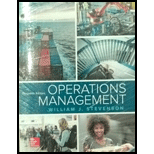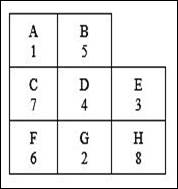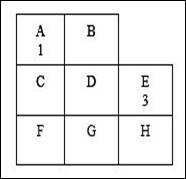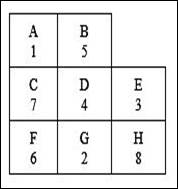
To determine: The new placement of departments that will minimize the total transportation costs.
Introduction:
Product layouts:
Product layout is a production system where the equipment and workstations are placed along the production and assembly lines. A conveyor is used to move the production units along the line. Product layouts have specialized labor to perform specific functions with the help of equipment (programmed to do a specific tasks in a repetitive manner). The layout is mostly based on the processing sequence.
Process layouts:
Process layout is a production system where the equipment is placed in a system based on their functions. The production line is planned to eliminate wastes. In certain process layouts, the machineries and work settings are not arranged as per the standardized production sequence. However, there would be an assembly having similar machineries and operational activities depending on the requirement. For example, paint department.
Answer to Problem 15P
Arrangement:

The total transportation cost for the arrangement is $143, 650 per day.
Explanation of Solution
Given information:
- Work centers 1 and 3 are assigned in two locations and cannot be moved.
- There are 8 work centers.
- Cost is $1 per load per meter.
- The departments are 1, 2, 3, 4, 5, 6, 7, and 8.
- The locations are A, B, C, D, E, F, G, and H.
Distances between locations (meters):
| To | A | B | C | D | E | F | G | H |
| From | ||||||||
| A | 40 | 40 | 60 | 120 | 80 | 100 | 110 | |
| B | 60 | 40 | 60 | 140 | 120 | 130 | ||
| C | 45 | 85 | 40 | 70 | 90 | |||
| D | 40 | 50 | 40 | 45 | ||||
| E | 90 | 50 | 40 | |||||
| F | 40 | 60 | ||||||
| G | 40 | |||||||
| H |
Number of load per day between departments:
| To | 1 | 2 | 3 | 4 | 5 | 6 | 7 | 8 |
| From | ||||||||
| 1 | 10 | 5 | 90 | 370 | 135 | 125 | 0 | |
| 2 | 360 | 120 | 40 | 115 | 45 | 120 | ||
| 3 | 350 | 110 | 40 | 20 | 190 | |||
| 4 | 190 | 70 | 50 | 200 | ||||
| 5 | 10 | 40 | 10 | |||||
| 6 | 50 | 20 | ||||||
| 7 | 20 | |||||||
| 8 |
Locations:

Arrangement of departments:
The numbers of trips between work centers is shown and are ranked from high to low.
| Work centers pair | Number of loads | Ranking |
| 1–2 | 10 | |
| 1–3 | 5 | |
| 1–4 | 90 | 11 |
| 1–5 | 370 | 1 |
| 1–6 | 135 | 6 |
| 1–7 | 125 | 7 |
| 1–8 | 0 | |
| 2–3 | 360 | 2 |
| 2–4 | 120 | 8 (Tied) |
| 2–5 | 40 | |
| 2–6 | 115 | 9 |
| 2–7 | 45 | |
| 2–8 | 120 | 8 (Tied) |
| 3–4 | 350 | 3 |
| 3–5 | 110 | 10 |
| 3–6 | 40 | |
| 3–7 | 20 | |
| 3–8 | 200 | 4 |
| 4–5 | 190 | 5 (Tied) |
| 4–6 | 70 | 12 |
| 4–7 | 50 | |
| 4–8 | 190 | 5 (Tied) |
| 5–6 | 10 | |
| 5–7 | 40 | |
| 5–8 | 10 | |
| 6–7 | 50 | |
| 6–8 | 20 | |
| 7–8 | 20 |
The table clearly indicates that work centers 1-5 have the highest number of trips between them. After that the following work centers have the most number of trips: 2-3, 3-4, 3-8, 4-5, 4-8, 1-6, 1-7, 2-4, 2-8 and others. After continuous trial and error method the following assignment is reached. It is to be noted that, except the pre assigned work centers, slight variations are reasonable in the assignment as long as work centers 2,4 and 8 are nearer to 3, 4 is nearer to 5 and 5 is nearer to 1.

Calculation of cost for each work center pair:
The cost for each department pair is calculated by multiplying the number of loads with the distance with the cost per load per meter.
Department 1-2:
Department 1-3:
Department 1-4:
Department 1-5:
Department 1-6:
Department 1-7:
Department 2-3:
Department 2-4:
Department 2-5:
Department 2-6:
Department 2-7:
Department 2-8:
Department 3-4:
Department 3-5:
Department 3-6:
Department 3-7:
Department 3-8:
Department 4-5:
Department 4-6:
Department 4-7:
Department 4-8:
Department 5-6:
Department 5-7:
Department 5-8:
Department 6-7:
Department 6-8:
Department 7-8:
Calculation of total cost:
The total cost is calculated by adding the cost of individual work center pairs.
The total transportation cost for the arrangement is $143,650.
Want to see more full solutions like this?
Chapter 6 Solutions
Loose Leaf for Operations Management (The Mcgraw-hill Series in Operations and Decision Sciences)
- The deaths are included in the discharges; this includes deaths occurring in less than 48 hours and postoperative deaths. Rehabilitation had 362 discharges, 22 deaths, 1<48 hours, 0 Postoperative. what is the gross death rate for the rehabilitation service?arrow_forwardA copy machine is available 24 hours a day. On a typical day, the machine produces 100 jobs. Each job takes about 3 minutes on the machine, 2 minutes of which is processing time and 1 minute is setup time (logging in, defining the job). About 20 percent of the jobs need to be reworked, in which case the setup time and the processing time have to be repeated. The remainder of the time, the equipment is idle. What is the OEE of the equipment?arrow_forwardHow do you think we can keep updating Toyota's ideas as new technologies come out and what customers want keeps changing?arrow_forward
- Given how TPS has helped change things in so many fields, do you think there are parts of it that might be hard to use in areas that aren’t about making things, like in healthcare or services? If so, why do you think that might be?arrow_forwardDo you feel there is anything positive about rework?arrow_forwardDo you think technology can achieve faster setup times? How would it be implemented in the hospital workforce?arrow_forward
- In your experience or opinion, do you think process changes like organizing workspaces make a bigger difference, or is investing in technology usually the better solution for faster setups?arrow_forwardHave you seen rework done in your business, and what was done to prevent that from occurring again?arrow_forwardResearch a company different than case studies examined and search the internet and find an example of a business that had to rework a process. How was the organization affected to rework a process in order to restore a good flow unit? Did rework hurt a process or improve the organization's operational efficiency? • Note: Include a reference with supportive citations in the discussion reply in your post.arrow_forward
- Setup time is very important in affecting a process and the capacity of a process. How do you reduce setup time? Give examples of reducing setup time. Please Provide a referenecearrow_forwardDo you think TPS was successful? If so, how? Are there other companies that have used TPS? If so, give examples. Please provide a referencearrow_forwardGiven the significant impact on finances, production timelines, and even equipment functionality, as you pointed out, what do you believe is the most effective single strategy a company can implement to significantly reduce the occurrence of rework within their operations?arrow_forward
 Practical Management ScienceOperations ManagementISBN:9781337406659Author:WINSTON, Wayne L.Publisher:Cengage,
Practical Management ScienceOperations ManagementISBN:9781337406659Author:WINSTON, Wayne L.Publisher:Cengage,

